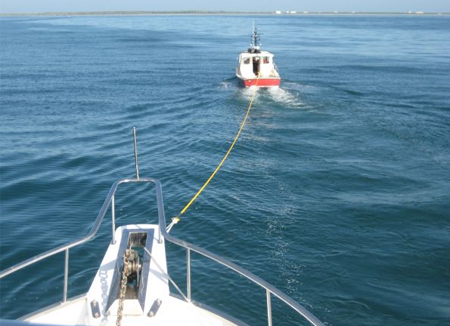
Another area of concern with the fresh water system is the pressure cap. This might seem trivial but having the pressure cap correctly sealed is another vital aspect to a properly functioning marine diesel engine. A conventional seal increases the pressure enough to raise the exact boiling point of water from 212° Fahrenheit to 250° Fahrenheit. If not properly sealed the water from inside your engine will boil causing your system to overheat. The caps on your raw fresh water cooling systems tend to get know around since they generally stick out like a turtle neck. I have seen boat detailers use them as a step to polish the engine chrome causing the caps to bend. When I don’t see the boat detailers do it I can always go back to my CCTV camera system and find the culprit who bent the pressure cap.
Changing your Marine Diesel Engine’s Antifreeze should be done at minimum of every 2 years. Don’t get the box store name brand pick one that has an extended life. Remember the pink is the higher quality brand whereas the green stuff doesn’t last nearly as long. Also only mix it with distilled water to ensure extra harmful ingredients aren’t introduced to your block.
Not too often do you get a chance to see the inside of the mixing elbow. The largest conduit in almost any marine engine room. This macaroni shaped part funnels exhaust and seawater from the marine diesel engine. These should be changed every 3 years at a very minimum but rarely does a boat owner do this, resulting in on of Diesel Services of America’s most common repair calls. Generally your engine won’t need repair if the maintenance has been done properly. Most of our work is maintenance but we can always count on plenty of mixing elbow service calls. I am amazed sometimes that these engines run when I get a peek inside the mixing elbow and see that the blockage is nearly 75 percent. The scaling and corrosion has a putrid smell that should be left up to Diesel Services of America if you would like to enjoy your next meal.
Marine Diesel Maintenance Tips part 2 is about to wrap up after we briefly cover the thermostat and heat exchanger. The freshwater side of your cooling system houses is where the thermostat resides. This little guy is the workhorse and very reliable even when it is constantly opening and closing one hundred to a thousand times a minute. The thermostat regulates coolant flow but does eventually break down over time and general wear and tear.
These last 2 procedures should definitely be left up to Diesel Services of America. You can quickly field test the thermostat after removing from the engine. Running a small piece of line thru the release valve and dangling it in the water and boil till it falls off the string. Then find out the temperature of water immediately that cause the valve to open and the thermostat to drop from string. Measuring the water in addition to the length of the opening hole on thermostat. Compare against specifications and replace the thermostat if not up to par.
The most intricate part of the cooling system is the heat exchanger. Even removing the heat exchanger requires working your way thru the labyrinth known as the cooling system. Every 3 years this should be taken out and sent of cleaning by a professional. This can easily take three to four hours removing and disassembling many parts and fittings.
![]()